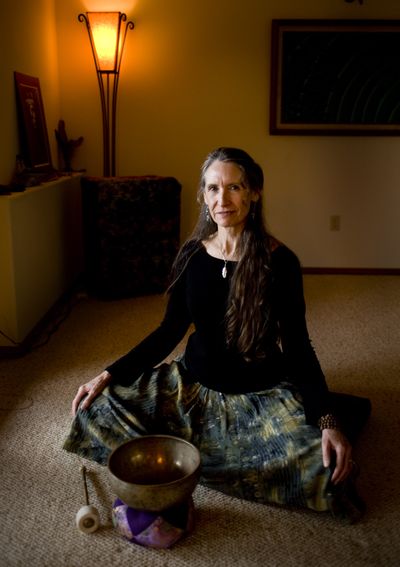Pointing the way to peace of mind
Spokane Valley meditation expert may not guarantee ‘stillness,’ but she will put you in position to find it

The ancient practice of meditation has a lot to offer your mental, physical and spiritual health. But if you think that it’s instantly going to “chill you out,” think again.
While this may be a residual side effect at some point, surprisingly, it’s not the end-goal, says Spokane Valley resident and meditation teacher Dori Langevin.
“It’s not that you’re going to be calm and peaceful,” Langevin says. “There’s no guarantee of that.
“The immediate benefit is in finding ‘stillness.’ When you gain this, you begin to have a choice about where your mind goes.”
And Langevin knows of what she speaks. The 58-year-old Los Angeles native has been practicing meditation for more than 12 years and has been a meditation instructor, teaching in various parts of the country, for more than six years.
Langevin holds a master’s degree in creative arts therapy and a doctorate in clinical psychology. Next June, she will complete an intense four-year course in “Insight Meditation” – also known as Vipassana, or “mindfulness meditation” – with world-renowned author and meditation teacher Jack Kornfield.
Mindfulness meditation is a form of meditation that focuses on the breath and present-moment awareness as a doorway to personal growth and transformation.
Jon Kabat-Zinn, director of the Stress Reduction Clinic at the University of Massachusetts Medical School and author of “Full Catastrophe Living” (Delta, 1990) and “Coming to Our Senses” (Hyperion 2005), teaches mindfulness meditation as a technique to help people cope with stress, anxiety, pain and illness.
His research indicates that long-term meditation slows the heart rate, creating a state of relaxation, and lowers levels of stress hormones such as cortisol. It can reduce hypertension and provide relief for asthma sufferers, making it easier to breathe.
Meditation also has been shown to slow the aging process.
A study led by Harvard researcher Sara Lazar, outlined in a 2005 NeuroReport magazine article titled “Meditation Experience is Associated With Increased Cortical Thickness,” found that meditation practice actually increased the gray matter of the brain. This affects the areas of the brain dealing with attention and sensory perception.
But Langevin knows that the physical health benefits of meditation are only the tip of the iceberg. With meditation, you learn that happiness is not dependent on a circumstance.
“It creates a quality of presence, good or bad, without needing to change anything,” she says.
“One of the benefits to meditation is that you are cultivating a relationship with direct experience, from moment to moment, recognizing what is sensation, and what is thought.”
One of the primary goals, Langevin says, is to become aware of one’s thoughts in a nonjudgmental way.
“Whatever mind-body state there is in any given moment, there’s no judgment or reaction to it,” she explains.
To begin practicing meditation, you just need to bring an intention.
“All you need is a genuine interest in self-reflection,” Langevin says. “You might have some curious questions such as: What is it that makes up this heart and mind of mine? How do I get caught in reactive patterns that cause suffering to myself and others? And how can I get free from these entanglements?”
She says she would remind first-time meditators that “this is an experiment. There’s no way to do it wrong.”
The intention is more important than the actual time you spend meditating, Langevin says.
You may begin with a few minutes and work your way up. Start with a comfortable place that you can visit once a day, even for just a minute.
“Intention comes first. Don’t set unrealistic time conditions for your first meditation, like planning to sit for an hour,” Langevin says.
“And if you want support, take a class or join a meditation group.”
A common fear surrounding meditation is that it will reveal otherwise buried emotional skeletons.
“People believe if they start meditating, they will find something really awful inside of them – something bad,” says Langevin. “In meditation, the idea is to sit with whatever ‘stuff’ you find without identifying with it. This is the key.”
You stop personally identifying with the “stuff’” that arises, she says, and begin to see it as more universal – the common human condition.
“It’s not what arises in meditation that’s important,” says Langevin, “but your reaction to it. The suffering is in the reaction.”
Should the goal be to get “good” at meditation?
“No,” warns Langevin. “There is a ‘clinging’ in that concept. Avoid spiritual idealism and let go of the idea of mastery.”
While not having enough time is a common excuse for not meditating, she points out that everyone has the same 24 hours in a day.
“Ask, ‘What is the deepest wish for myself?’ This is really about a commitment to a deeper understanding of yourself.”
The practice of meditation aids people in slowing down and observing thought processes before reacting to events around them, Langevin says.
“As the mind settles, the body settles,” she says. “In this, there are increased options in choices, instead of always reacting from habitual patterns.”
That, she says, is a place of real freedom.
“Here you are given the choice to make any given situation harder or easier,” Langevin says.
“Our essential nature is wisdom and compassion, despite our reactive patterns to people and circumstances around us. In meditation, we begin to live more from our intent.”